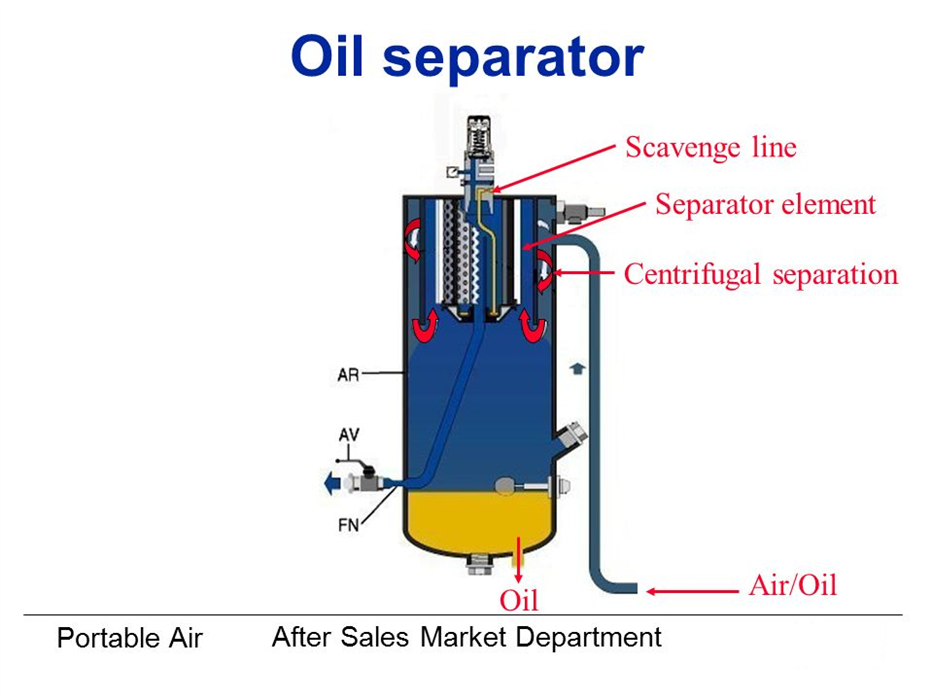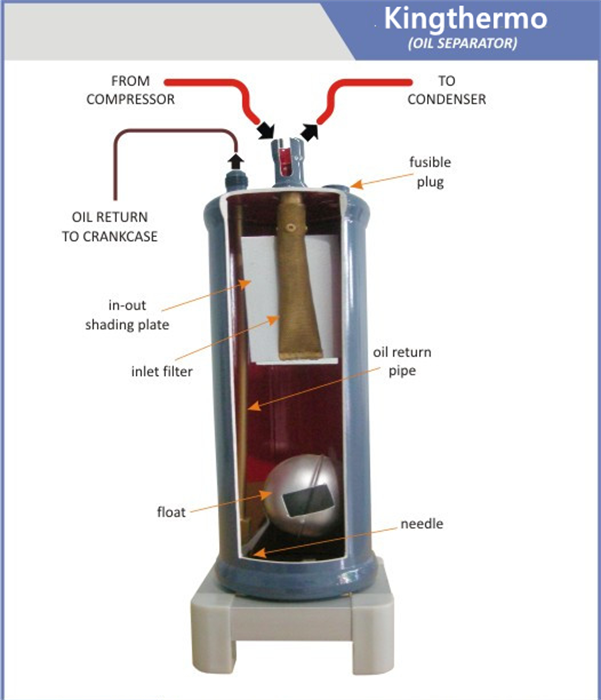17
2020
(1) Function of oil separator
In the vapor compression refrigeration system, the compressed ammonia steam (or Freon steam) is superheated at high pressure and high temperature. Because of its fast flow rate and high temperature. Due to the high temperature, some lubricating oil on the cylinder wall will inevitably form oil vapor and oil droplet particles, which will be discharged together with refrigerant vapor. The higher the exhaust temperature and the faster the flow rate, the more lubricating oil will be discharged. For the ammonia refrigeration system, because ammonia and oil are not mutually soluble when the lubricating oil enters the condenser and evaporator together with the refrigerant, it will condense into an oil film on the heat transfer wall and increase the thermal resistance, which will reduce the heat transfer effect of the condenser and evaporator and reduce the refrigeration effect. According to relevant data, when 0.1 mm oil film is attached to the evaporation surface, the evaporation temperature will be reduced by 2.5 ℃, and the power consumption will be increased by 11 ~ 12%. Therefore, an oil separator must be set between the compressor and the condenser to separate the lubricating oil mixed in the refrigerant vapor. To sum up, the main functions of oil separator are as follows:
- Ensure that the lubricating oil returns to the oil storage tank of the compressor, prevent the compressor from failure due to the lack of lubricating oil, and extend the service life of the compressor.
- The interaction between the decrease of flow speed and the change of flow direction causes the accumulation of lubricating oil, so that the separated lubricating oil under high temperature is collected and automatically returned to the crankcase, which improves the efficiency.
- Prevent the compressor from liquid hammer.
- Give full play to the efficiency of condenser and evaporator.
- Reduce the vibration and noise at the high voltage end of the system.
- At the same time, these features can also reduce the power cost of the system.

(2) Working principles of oil separator
As we all know, the size of liquid particles driven by steam flow is related to the speed of steam flow. If the lift generated by the vertical upward movement of the steam flow is balanced with the weight of the particles, the steam flow velocity is called the equilibrium velocity, and is represented by the symbol o. Obviously, when the steam flow speed equals to the equilibrium speed, the particles will remain in the steam flow; if the steam flow speed is greater than the equilibrium speed, the particles will be taken away; when the steam flow speed is less than the equilibrium speed, the particles will fall down, thus separating the oil droplets from the refrigerant steam flow.
The basic working principle of the oil separator is to make use of the different densities of lubricating oil and refrigerant vapor, and the sudden expansion of the cross-section of the passage, resulting in the sudden drop of the airflow velocity (the diameter of the oil separator cylinder is 3 ~ 15 times larger than that of the high-pressure exhaust pipe, so that the steam flow velocity after entering the oil separator is reduced from the original 10 ~ 25m / s to 0.8 ~ 1m / s); at the same time, the flow direction is changed to separate the lubricating oil with higher density It is deposited at the bottom of the oil separator. To enhance the separation effect of oil, centrifugal force is used to throw out the oil drops, ammonia liquid is used to wash, water is used to cool the steam body to reduce the temperature of the steam body, so that the oil vapor condenses into oil drops, or a filter layer is set.

(3) Form and structure of oil separator at present, there are four common types of oil separator: washing type, centrifugal type, filtering type and packing type. Their structure and working principles are described below.
- Washing oil separator
Washing type oil separator is suitable for ammonia system. Its main body is a cylinder made of steel plate, and its two ends are welded with cylinder cover and bottom pressed by steel plate. The steam inlet pipe extends into the ammonia liquid at the lower part of the cylinder from the center of the cylinder cover. A bottom plate is welded at the lower end of the intake pipe, and an air outlet is opened around the pipe end, so as to prevent the high-pressure steam from directly impacting the bottom of the cylinder and stirring up the settled lubricating oil. The middle part of the intake pipe (above the liquid level) in the cylinder is also provided with a balance hole on the pipe wall, which is used to balance the pressure among the exhaust pipe, oil separator and condenser when the compressor stops. Especially when the compressor has an accident, it can prevent the ammonia in the oil separator from being hydraulically returned to the compressor due to the high pressure of the condenser, causing more accidents. A porous umbrella baffle is also arranged on the upper part of the outer side of the air intake pipe for separating liquid drops. The lower side of the cylinder body is provided with a drain pipe joint, which is connected with the oil collector. The side of the cylinder above the umbrella baffle is provided with an outlet pipe joint, which makes the outlet pipe extend into the cylinder for a certain length, and the outlet is opened upward. The purpose is to make the ammonia steam flow again before it is discharged from the separator, which helps to improve the separation effect, as shown in Figure 1.
The washing oil separator mainly uses the mixed gas to be washed and cooled in ammonia liquid to separate the oil. At the same time, it also uses the separation function of reducing the airflow speed and changing the direction of airflow, and the natural settlement of oil droplets. The washing and cooling have the greatest influence on the oil separation efficiency of the washing oil separator, so a certain height of ammonia liquid must be kept in the cylinder.
The ammonia liquid in the washing-type oil separator is generally supplied by the condenser. In order to ensure that there is enough ammonia liquid in the oil separator, its liquid inlet pipe should be 240 ~ 250mm lower than the liquid outlet of the condenser. In addition, it is generally installed outside the machine room, close to the condenser, so that multiple compressors can use one oil separator together.
- Packed oil separator
The structure of the packed oil separator is shown in Fig. 2. A packing layer is installed in the cylinder made of rolled steel plate, and the upper and lower parts of the packing layer are fixed with two porous steel plates. The filler can be ceramic cup, metal chip or wire mesh, and the wire mesh is the best. When the refrigerant vapor with oil enters the cylinder to reduce the flow rate, it first absorbs the oil mist through the packing, then goes down the cylinder wall along the expansion direction of the umbrella plate, and then changes the flow direction to return to the top cavity from the central pipe for discharge. The separated oil is deposited at its bottom and then discharged back to the compressor crankcase through the ball valve or manual valve.
It can be seen from the above that the oil separation of this kind of oil separator is realized by reducing the flow rate, packing adsorption and changing the direction of airflow, in which the adsorption of the packing layer is the main one. Compared with the washing type oil separator, the oil separation efficiency of the packed type oil separator is higher, up to 95% (80 ~ 85% for the washing type). The installation position is compact, and there are no strict requirements for the installation position and height. It can be used by multiple compressors in one oil separator, so the packed type oil separator has been widely used in ammonia refrigeration system. However, the packed oil separator has a large resistance to air flow, and the flow rate of refrigerant vapor in the cylinder is required to be no more than 0.5m/s. In addition, the wire mesh of the packed oil separator is generally stainless steel wire mesh, which is expensive.
- Centrifugal oil separator
The centrifugal oil separator has a good oil separation effect and is suitable for large refrigeration system. Its structure is shown in Fig. 3. The exhaust gas of the compressor enters the cylinder along the tangent direction through the intake pipe of the oil separator, and then rotates at high speed along the spiral guide vane and flows from top to bottom. Under the action of centrifugal force, the oil droplets with higher density in the exhaust gas are thrown on the cylinder wall and separated, and flow down the wall and deposit at the bottom of the cylinder. The steam is led out through a porous plate in the air outlet pipe in the center of the cylinder. A ball valve is installed on the cylinder side. When the oil level rises to the upper limit, the lubricating oil opens the valve core through the ball valve and automatically discharges oil to the compressor crankcase or oil collector. Some oil separators are also equipped with cooling water jacket, in which the mixture is cooled by the cooling water, and further separated by reducing the flow rate and changing the flow direction.
- Filter oil separator
The filter oil separator is used in Freon refrigeration system, which is often called Freon oil separator. Its structure is shown in Figure 7-4. When the high-pressure refrigerant gas discharged from the compressor enters the separator, due to the large cross-section, the gas flow rate suddenly decreases and changes direction. Coupled with the filtering effect of several layers of wire mesh during the intake, the lubricating oil mixed in the gas refrigerant is separated, and drops down and collects at the bottom of the container. When the accumulated lubricating oil reaches a certain height, it will return to the compressor crankcase through the automatic oil return valve. In normal operation, due to the intermittent operation of the ball valve, the oil return pipe is cold and hot, the oil return pipe is hot, and the pipe is cold without oil return. If the oil return pipe is always cold or hot, it means that the ball valve has failed and must be overhauled. The manual oil return valve can be used for oil return. This kind of oil separator is simple in structure, convenient in manufacture and widely used, but its oil separation effect is not as good as that of packing type.